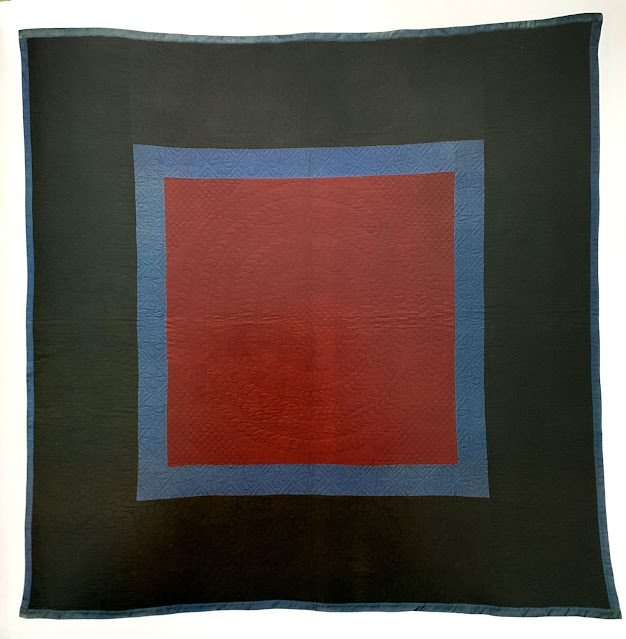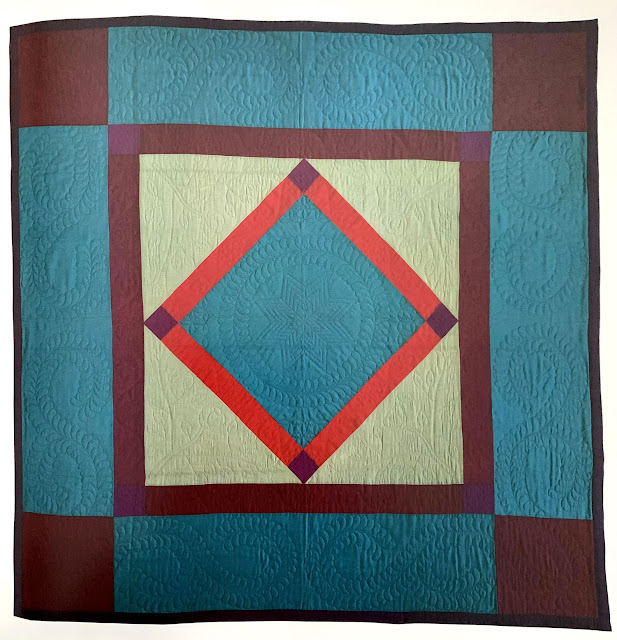This post looks at the 'Square in Square' and the 'Diamond in Square' quilts made between 1890 - 1940 by Amish women in Lancaster County, Pennsylvania. The images include commentary by Julie Silber and are taken from the beautiful book The Art of the Quilt (1990). Also included in the book is an essay by art critic Robert Hughes. The book is a coffee table sized catalog containing about 80 quilts from the larger 350 piece Esprit collection and accompanied an exhibition at the San Francisco de Young museum. At least 82 of the Esprit quilts have returned to Lancaster County and it is possible to visit them. Read more I've woven some of Robert Hughes' essay in with the 8 masterpieces in italics.
I've long been inspired by these quilts and this is not my first post on the subject. In 2010 my husband I visited Lancaster County and I posted then about seeing some Amish quilts face to face with close up photos of the stitching. here
To make a quilt you take 3 pieces of cloth and sew them together to make a kind of padded blanket.
These Lancaster County quilts are a warm, soft, swaddling minimalism. These quilts are just a tad more aloof than most of the things that folk cultures produce.
Folk art, like vernacular speech, may be whimsical. It is never inflated. It wants to be understood by everyone who sees it, and so it tends towards conciseness and practicality.
Virtually all Amish women were quiltmakers.
These things were not anonymous when they were made. These quilts were the intense and focused expression of individual people who made them for their families and who were proud of their skills.
A fine Amish quilt has:
a spare-ness of design,
almost dogmatic rigor but not because of its inventive quirks,
a magnificent sobriety of color,
a balanced amplitude of conception,
a truly human sense of scale.
The quilts on these pages are like emissaries from a vanished world.
If folk art means images that high taste can condescend to in the very act of savoring them, then Lancaster quilts are not folk art. The quilts radiate a fierce distinction, a forthright economy of means, a syntax that is governed by strict traditions and yet looks inescapably modern.
They are a high enclave within Amish quilts.
Lancaster County quilts have large geometrical colour fields.
They use deep, saturated colour but not usually black.
Lancaster quilts have peculiar designs, like Diamond in the Square.
Lancaster quilts use a central medallion structure.
Lancaster quilts use elaborate quilting and contrasting thread and are made from fine wool, not cotton. You look at them and think How Modern.
But they are not modern. They come from a culture to which modernism is anathema.
What is the Theory of Amish quilt making? It is too simple to say that they do it to keep warm. There are much easier ways to obtain a blanket than by patiently expending hundreds or thousands of hours.
What is the Theory of Amish quilt making? It is too simple to say that they do it to keep warm. There are much easier ways to obtain a blanket than by patiently expending hundreds or thousands of hours.
Here is an activity that is part practical and part aesthetic. Part ritualistic and part social binder. It is not pure creativity, neither is it pure use.
Quilt making falls under religious rules governing social customs, moral life and work. It directs the Amish towards the cardinal virtues: Humility, non-resistance, simplicity and practicality.
Lancaster Amish have saturated colors. No white and no yellow.
The quilts are made from dress and shirt fabric, but the Lancaster county Amish also bought cloth especially for their quilts. They did not wait for suitable scraps.
In their complexity, visual intensity and quality of craftsmanship, such works simply dispel the idea that folk art is innocent social birdsong. They are as much a part of the story of high aesthetic effort in America as any painting or sculpture.
They deserve our attention and abundantly repay it. Robert Hughes.








2 comments:
How Robert Hughes distills the making into a single line, "To make a quilt you take 3 pieces of cloth and sew them together to make a kind of padded blanket" ... although he does later credit the making as taking "hundreds or thousands of hours"
Known as a fierce art critic, incredibly dismissive of many famous 20th century artists, his words here are fascinating in their recognition of quilts as art.
I've never read his work, but now I want to ... have put a reserve on his survey of American art and look forward to learning more. And here I pause to wonder that this is the first time I have considered doing so, because Robert Hughes was, for many many years, known to me as "the famous art critic who lived down the road" from my parents house on Shelter Island.
I have that book - The Art Of The Quilt - and it is a beautiful book. One of my brothers bought it for our Mom for either Mother's Day or for her birthday. After Mom passed away, my brother thought I should have the book since I am the only one who quilts. I do treasure that book. I live near Amish country in Holmes County Ohio and it is amazing the difference in style from the Pennsylvania Amish, Ohio Amish and the Indiana Amish.
Post a Comment